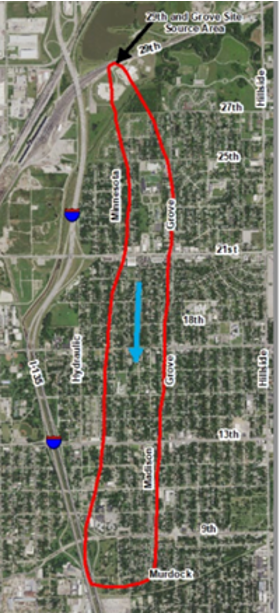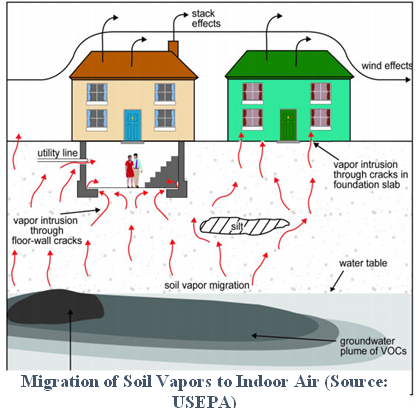Imagine a scene with rail cars lined up at one of Union Pacific’s railyards in Kansas. This railyard happens to be in northeast Wichita, just north of a park where children play and drink well water from a fountain.

Next, picture railroad workers back in the 1970s or 80s pouring or spraying a highly toxic chemical on the gears and wheels of the cars to clean the oil and grease buildup. Envision this liquid spilling onto the ground and soaking into the soil, eventually reaching the aquifer approximately 15 feet below the surface. Imagine that degreasing scenario repeatedly happening over the years as hundreds, perhaps thousands of gallons of the cancer-causing liquid, trichloroethylene (TCE), seep into the aquifer, eventually traveling south and impacting Wichita neighborhoods.
You must imagine it because no one knows how Union Pacific spilled TCE at the railyard. However, evidence shows it was spilled in amounts significant enough to contaminate the aquifer below the railyard at levels 86,000 times the standards set by the Kansas Department of Health and Environment (KDHE). By 2003 or earlier, the contaminated plume spread 2.9 miles south and several blocks wide in the aquifer below predominantly black neighborhoods, including Northeast Millair, Power, and North Central.
To this day, the levels in the aquifer are over 164 times higher than KDHE drinking water standards. Residents with a well can be exposed by drinking, showering, or cooking with the well water.
 Additionally, residents may have been and currently be exposed to TCE by inhaling it. TCE readily turns into a toxic gas. When it has polluted an aquifer, it vaporizes and moves upward through the soil and can enter homes from below, seeping through the tiniest cracks and openings. The aquifer is only 13 –19 feet below the surface, providing a relatively short distance for TCE to travel. Yet, the KDHE has not tested homes for TCE since 2012 and 2013, at which time it detected TCE. Notably, the monitoring was only done in seven residents and three public buildings. There are approximately 2,500 homes in the plume area.
Additionally, residents may have been and currently be exposed to TCE by inhaling it. TCE readily turns into a toxic gas. When it has polluted an aquifer, it vaporizes and moves upward through the soil and can enter homes from below, seeping through the tiniest cracks and openings. The aquifer is only 13 –19 feet below the surface, providing a relatively short distance for TCE to travel. Yet, the KDHE has not tested homes for TCE since 2012 and 2013, at which time it detected TCE. Notably, the monitoring was only done in seven residents and three public buildings. There are approximately 2,500 homes in the plume area.
To aggravate the situation, the KDHE knew about the contamination as early as 1994 and traced it to the Union Pacific railyard. However, KDHE failed to take adequate measures to compel Union Pacific to begin mitigation measures when the contamination was discovered. It was not until September of 2022 that KDHE had a public meeting to inform residents of the contamination and Union Pacific’s cleanup plan—almost 30 years later.
Residents expressed surprise, anger, and frustration at that meeting, the first time most of them heard about the contamination. To add to the sense of betrayal, the KDHE told citizens that dealing with contamination is “expensive” and it needed “to be careful with the money.” Money is apparently better spent elsewhere.
Allowing marginalized communities to be disproportionately impacted by pollutants is an environmental injustice. Such injustice is rearing its ugly head in Wichita, where a historically black community has been exploited by a corporation and discounted by its state. Citizens have expressed the sentiments that they have been forgotten and that no one cares about them.
Union Pacific knew or should have known about the environmental catastrophe caused by its degreasing practices that used large amounts of TCE. Union Pacific was reckless when it allowed TCE to severely contaminate the groundwater and air. Corporations cannot be allowed to continue poisoning our communities and environment. They must be held accountable for the damage they have done and continue to do. The status quo is unacceptable.
No money can compensate individuals in northeast Wichita suffering from cancer and other debilitating diseases linked to the TCE contamination. Nor can money bring back loved ones lost to these illnesses. However, monetary penalties can cover the costs of medical bills, health monitoring, and air monitoring and—if impactful enough—will hopefully deter this kind of behavior in the future.
Learn more at our website dedicated to the 29th & Grove site
